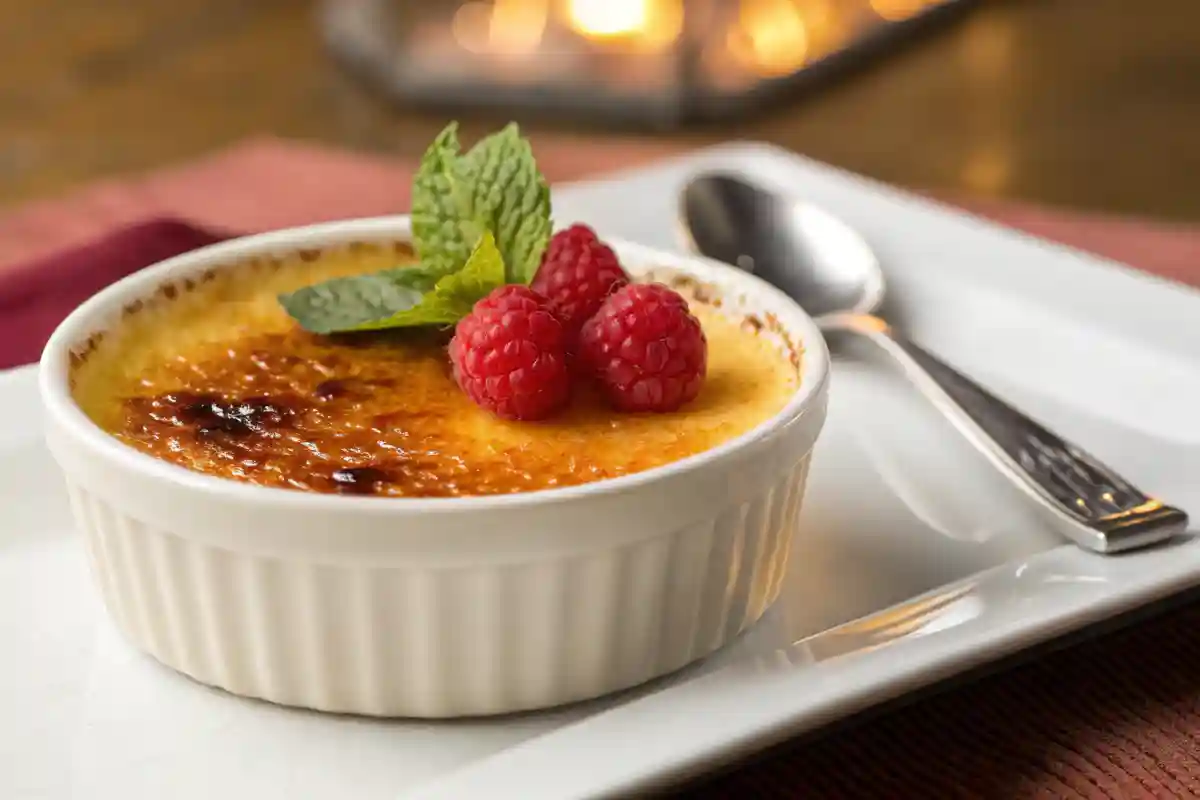Crème brûlée, with its silky custard base and irresistible caramelized sugar topping, is a dessert that epitomizes elegance. This delightful French treat combines simplicity and sophistication, relying on a handful of basic ingredients that work harmoniously to create its luxurious texture and flavor. In this article, we’ll explore what crème brûlée is mostly made of, examine the key roles each ingredient plays, delve into recipe variations, and offer practical tips for making it yourself. Let’s dive in!
Introduction to Crème Brûlée
The History and Origin of Crème Brûlée
Crème brûlée, which translates to “burnt cream,” is a dessert steeped in culinary history. It’s widely believed to have French origins, though similar dishes appear in English and Spanish cuisine under names like Trinity Cream or Crema Catalana. Its hallmark is the contrast between the creamy custard base and the hard caramelized sugar topping—a delightful play of textures that’s captivated dessert lovers for centuries.
Importance of Understanding Its Ingredients
Why focus on ingredients? Well, the secret to crème brûlée’s creamy, melt-in-your-mouth texture and its perfect crackly top lies in the precision of its components. Heavy cream, egg yolks, sugar, and vanilla—these are the building blocks of this classic dessert. By understanding how these elements interact, even novice cooks can master the art of crème brûlée.
From its humble beginnings to its status as a quintessential fine-dining dessert, crème brûlée showcases the magic that happens when basic ingredients are treated with care. Let’s move on to uncover what truly makes up this iconic dish!
Core Ingredients of Crème Brûlée
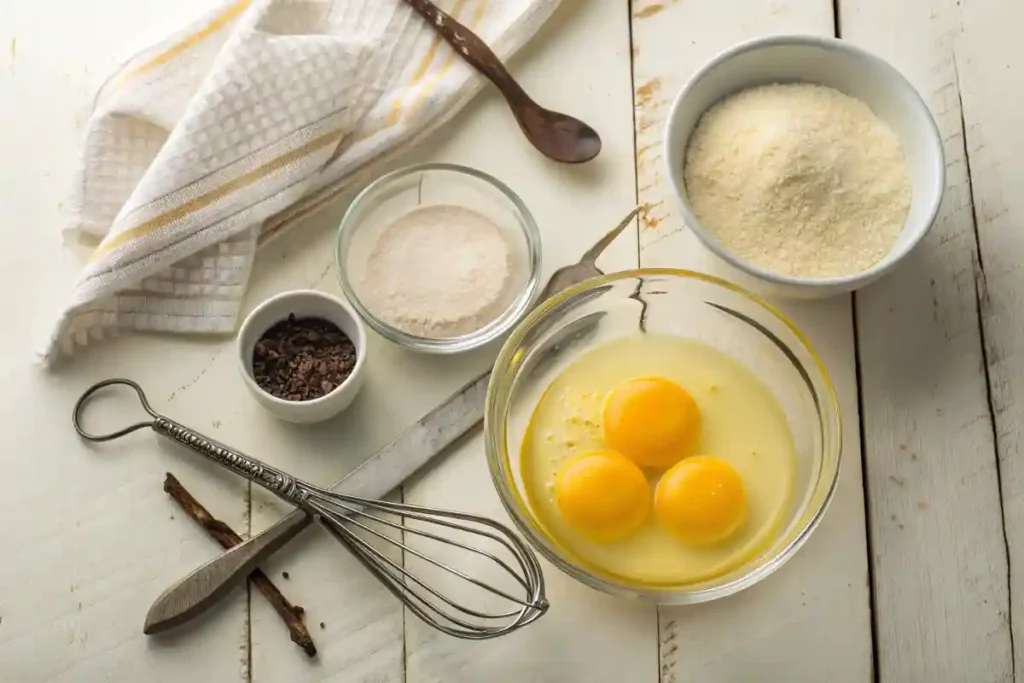
Heavy Cream: The Base of the Custard
The primary ingredient in crème brûlée is heavy cream, which gives the custard its signature richness and smooth texture. Heavy cream is preferred over milk for its high fat content, creating that luxurious, melt-in-your-mouth feel. Using high-quality cream enhances the dish’s overall flavor, making it a key element when answering what is crème brûlée mostly made of?. Be sure to warm the cream before mixing it with other ingredients to ensure a consistent custard base.
Egg Yolks: The Key to Texture
Egg yolks are the backbone of crème brûlée’s structure. Acting as a natural thickener, they work with the heavy cream to create a custard that’s both firm enough to hold its shape and creamy enough to glide across your palate. For the perfect balance, only yolks are used—egg whites are omitted because they can create a rubbery texture.
Sugar: For Sweetness and Caramelization
Sugar serves a dual purpose in crème brûlée. It sweetens the custard and, when caramelized, forms the dessert’s iconic crunchy topping. Granulated sugar is most commonly used because of its even melting properties. The contrast between the creamy custard and the crackly caramelized sugar crust is what makes crème brûlée a standout dessert.
Vanilla: Adding Depth of Flavor
Vanilla elevates the custard’s flavor with its warm, aromatic notes. Traditional recipes use vanilla beans, but vanilla extract is an accessible alternative. Infusing the cream with vanilla enhances its aroma and taste, leaving no doubt why this ingredient is indispensable when exploring what crème brûlée is mostly made of. For an extra burst of flavor, some chefs even incorporate a touch of salt or citrus zest. For tips on selecting the best cream for your dessert, check out What Type of Cream for Crème Brûlée?
Variations in Recipes and Their Ingredients
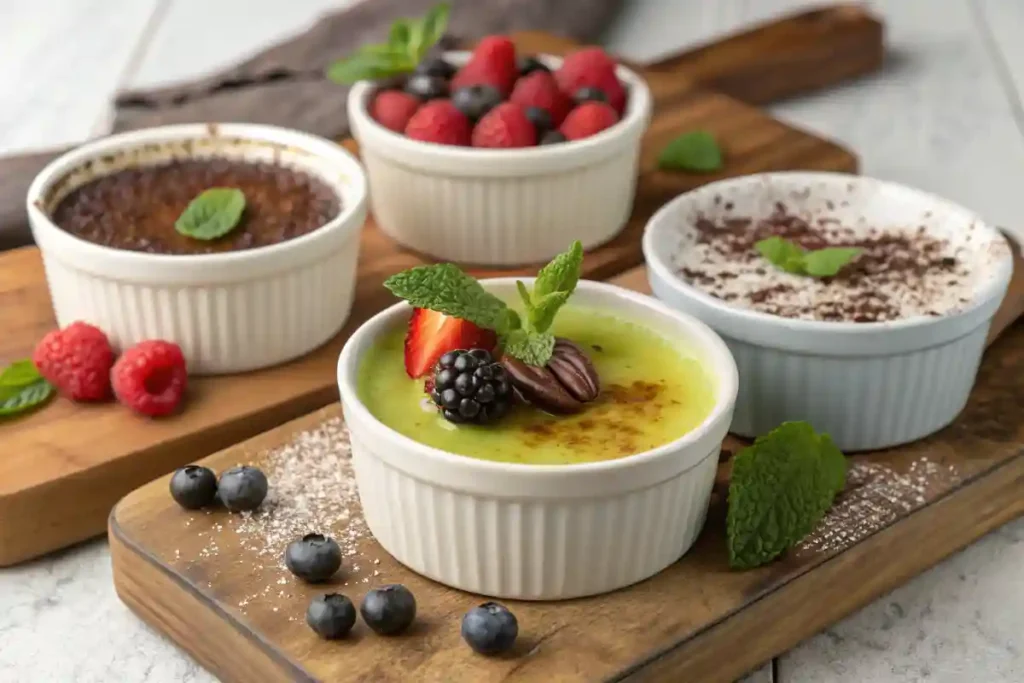
Common Substitutions and Additions
While the classic crème brûlée recipe sticks to a simple formula, creative chefs often experiment with substitutes and add-ins. For instance, coconut milk or almond milk can replace heavy cream for a lighter or dairy-free option. Incorporating liqueurs like Grand Marnier or Amaretto adds a sophisticated twist, while chocolate or coffee infusions give the dessert a bold new flavor profile.
Regional Twists and Unique Flavors
Around the world, crème brûlée takes on regional identities. In Spain, crema catalana features a citrus-infused custard base. In Asia, flavors like matcha (green tea) and pandan offer exotic spins on the classic. These regional adaptations highlight how this timeless dessert evolves while retaining its core identity—showcasing the simplicity of what crème brûlée mostly consists of.
How the Ingredients Affect the Final Dish
The Role of Each Ingredient in Texture and Taste
Each ingredient in crème brûlée contributes to its unique texture and flavor profile. Heavy cream, with its high-fat content, creates a custard that is rich and velvety. Egg yolks, on the other hand, add a creamy density and act as the binding agent, ensuring the custard sets perfectly without becoming rubbery. Sugar enhances the dessert’s sweetness while also playing a pivotal role in the caramelized topping, which adds a contrasting crunch. Vanilla rounds out the flavors, giving the custard its warm, aromatic undertone.
The perfect crème brûlée is a balance of these components, demonstrating how its simple yet precise ingredients contribute to its charm. Even slight changes in their proportions can impact the final texture and flavor, highlighting the critical role of careful preparation.
Achieving the Perfect Caramelized Sugar Layer
The caramelized sugar layer defines the essence of crème brûlée. To create it, a thin layer of granulated sugar is evenly spread over the custard and then carefully torched or broiled until it melts and hardens. This step is crucial—not only for adding a satisfying crunch but also for enhancing the dessert’s visual appeal. The contrast between the creamy custard and the crisp sugar topping is what elevates this dessert to a true culinary masterpiece. For more tips on perfecting your crème brûlée’s topping, consider exploring The Secret to Crème Brûlée.
Step-by-Step Guide to Making Crème Brûlée
Preparing the Custard Mixture
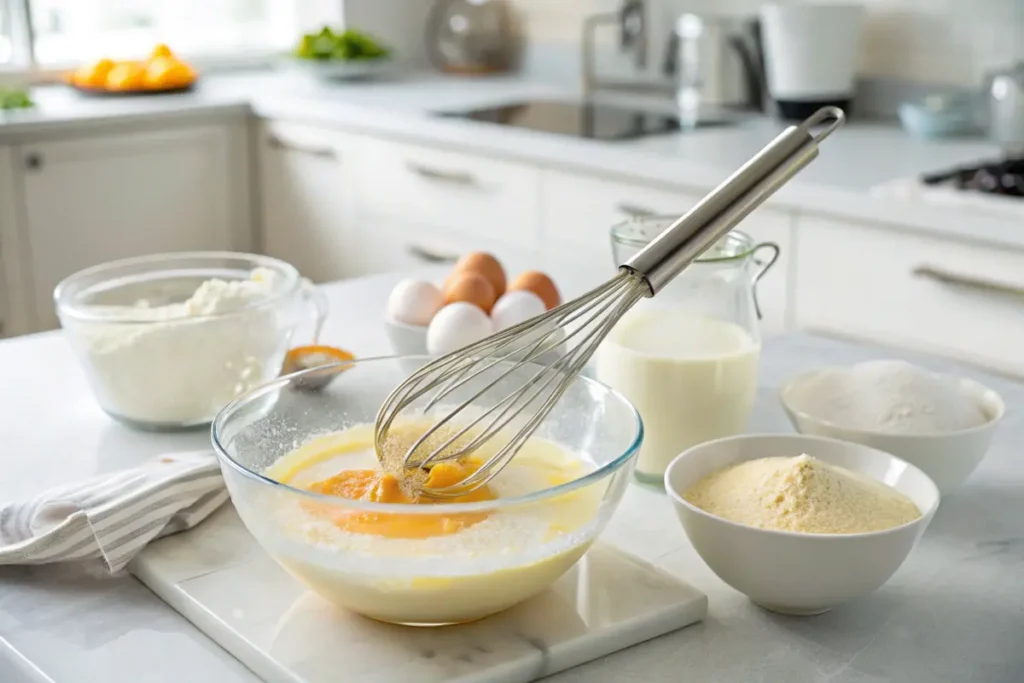
Start by gently heating the heavy cream with vanilla to infuse the custard with flavor. While the cream is warming, whisk together egg yolks and sugar in a separate bowl until the mixture is pale and creamy. Slowly pour the warm cream into the egg mixture, stirring continuously to avoid cooking the eggs. This creates a smooth custard base, essential for the perfect crème brûlée.
Baking the Custard to Perfection
Pour the custard mixture into individual ramekins and place them in a deep baking dish. Add hot water to the dish, enough to cover the ramekins halfway. This water bath ensures even cooking, preventing the custard from curdling. Bake the ramekins at a low temperature until the custard is just set—it should jiggle slightly in the center when done.
Caramelizing the Sugar Topping
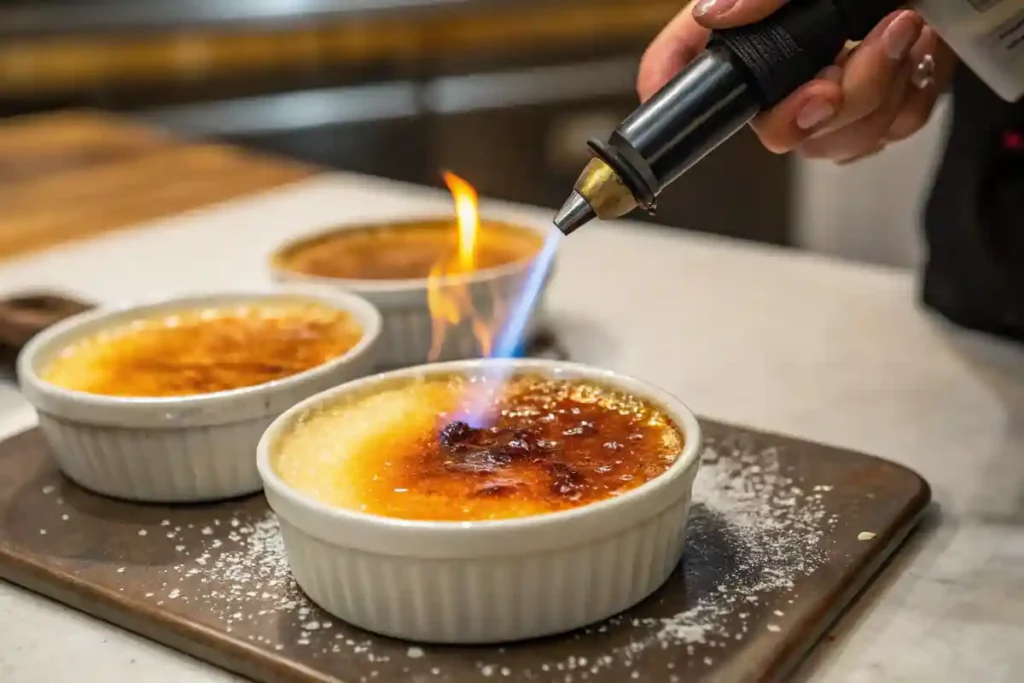
Once the custard has cooled and set, it’s time for the finishing touch: the caramelized sugar topping. Sprinkle an even layer of granulated sugar over each ramekin. Use a kitchen torch to melt the sugar until it forms a golden, crackly layer. If you don’t have a torch, you can use the oven broiler, but keep a close eye to avoid burning.
Tips for Success and Common Mistakes
Key Techniques for a Silky Texture
Achieving the perfect crème brûlée requires attention to detail, especially when creating the custard. When adding the warm cream to the egg mixture, always do so gradually while whisking. This prevents the eggs from scrambling and ensures a smooth texture. Straining the custard through a fine sieve before pouring it into ramekins is another essential step, as it removes any lumps and guarantees a silky finish.
The baking process also matters. Use a water bath to maintain even heat distribution. Covering the baking dish loosely with foil can help prevent the tops from browning too early. Finally, once baked, let the custard cool completely before caramelizing the sugar topping for the best results.
Avoiding Overcooked or Grainy Custard
Even slight errors can lead to overcooked or grainy custard. Overbaking is a common pitfall—remember, the custard should still have a slight jiggle in the center when removed from the oven, as it will firm up while cooling. Additionally, using too high a heat while caramelizing the sugar can melt the custard underneath, ruining its consistency. These small details make a big difference in answering what is crème brûlée mostly made of—precision and care in handling each ingredient!
FAQs About
Can You Make Crème Brûlée Without a Torch?
Absolutely! While a kitchen torch is the most convenient tool for caramelizing sugar, you can achieve similar results using your oven’s broiler. Place the ramekins under the broiler on high heat, watching closely to prevent burning.
What Can Be Used Instead of Heavy Cream?
If you’re looking for alternatives to heavy cream, full-fat coconut milk or almond milk can work, though they’ll alter the flavor. These substitutions cater to dietary needs but may result in a less creamy texture.
How Long Does Crème Brûlée Last?
When stored properly, crème brûlée can last for up to three days in the refrigerator. However, it’s best to caramelize the sugar topping just before serving to maintain its crunch.
Is Crème Brûlée Gluten-Free?
Yes! Traditional crème brûlée recipes, made with heavy cream, egg yolks, sugar, and vanilla, are naturally gluten-free. Be cautious when using flavored extracts or toppings, as some may contain additives.
Creative Ways to Serve Crème Brûlée
Pairing Crème Brûlée with Complementary Flavors
Crème brûlée is a versatile dessert that pairs beautifully with other flavors. Serve it with fresh fruits like berries or tropical slices to add a tangy contrast to its creamy richness. For a more indulgent twist, drizzle caramel or chocolate sauce on the side. These combinations not only elevate the dessert but also provide variety, making every bite delightful.
For a seasonal touch, consider infusing the custard with spices like cinnamon or nutmeg during the holidays. Each variation still answers the question what is crème brûlée mostly made of? while adding a fresh perspective to its classic form.
Unique Presentation Ideas
Beyond the classic ramekin, get creative with how you present crème brûlée. Use small glass jars for a rustic look or hollowed-out fruits like oranges or coconuts for a tropical flair. Miniature versions served in spoons or shot glasses are perfect for parties, offering a bite-sized indulgence that guests will adore.
When thinking about presentation, keep in mind that the crackly sugar topping is a visual centerpiece. A golden, even caramelized layer instantly enhances the dessert’s appeal.
Why Crème Brûlée Remains Timeless
A Perfect Balance of Simplicity and Elegance
What makes crème brûlée so enduring? It’s the simplicity of its ingredients—heavy cream, egg yolks, sugar, and vanilla—that transforms into an elegant, show-stopping dessert. These basic elements, when treated with care, create a dish that feels luxurious yet approachable. This timeless appeal highlights the importance of its core ingredients and explains why it continues to resonate across generations.
A Versatile Dessert Loved Worldwide
Crème brûlée’s adaptability has helped it maintain its status as a dessert favorite worldwide. Whether served in its classic form or infused with modern twists like matcha or espresso, it continues to delight. Its combination of creamy custard and caramelized sugar offers a sensory experience that few desserts can match.
From fine dining establishments to cozy home kitchens, crème brûlée remains a celebration of what simple, high-quality ingredients can achieve when skillfully prepared. Its legacy is a testament to the enduring charm of traditional desserts.

